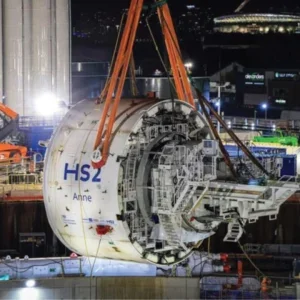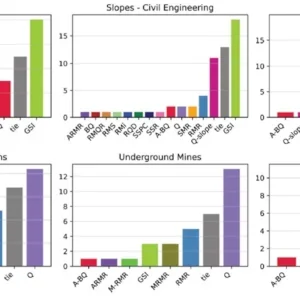Road tunnels are often ventilated by inductive systems with booster fans, also known as jet fans, installed near the tunnel ceiling. A brief summary of physical data is necessary to better understand the scope of this paper.
The theoretical impulse force for a jet fan, thrust, can be calculated as follows: ![]()
In practice a jet fan experiences losses and so will not develop the full theoretical thrust force.
The actual thrust can only be found by measurement. Action and reaction are equal and opposite so the thrust provided to the air can be evaluated by measuring the reactive force on the fan, as specified in ISO 13350. The difference between theoretical and real thrust ranges from 0.85 to 1.05 (values greater than one happen in some cases where a high hub ratio generates a remarkable annulus velocity, affecting outlet velocity). The authors warn the user on calculating the thrust with the above formula. It is recommended to measure the thrust and then calculate the Veff (effective velocity) from the appropriate formula [1].
Since the flow rate in the tunnel will not be zero, formula (1) must be rewritten in the following way :![]()
Manipulating this formula
![]()
and solving the equation for Tf we have:![]()
In order to free as much of the tunnel for traffic as possible, booster fans are often installed close to the ceiling. This results in the exhaust jet stream not being able to fully develop. So a portion of jet energy is lost to wall friction. Consequently, formula (3) has to be rewritten as follows:
![]()
The effectiveness number k, called the ‘Kempf factor’, indicates what portion of the impulse force or momentum is actually provided by the fan and not lost.
Generally we should assume:
![]()
And we immediately have a factor of
![]()
Studies, presented later in this paper, demonstrate that k can range between 0.65 to 0.78, resulting in a correction factor on the provided thrust of 0.54 to 0.64. This means a loss in thrust of 36 to 46 per cent. This is a remarkable amount of energy loss, and needs an appropriate focus.
History
During the mid 1960s a Swiss engineer, I Kempf, started to study the influence and effect of walls on jet streams [2] in a corner of rectangular tunnel section model. That was the first approach trying to determine the effects in an engineered way. Later in 1979 E. Rohne [3] resumed the previous work and began an analytical investigation of a simple jet on a plain plate. In 1982 Rohne [4] also studied the simple jet in a niche. And again in 1985 [5] and 1988 [6] Rohne studied the effect of two and four simple jets on a plain plate.
All Rohne experiments were purely a pipe or pipes positioned in the vicinity of a plain plate or plain niche, and not taking into account the shape of the tunnel at all. This research showed the great influence of losses generated through interaction between jet plumes and fixed surfaces.
In 1991 [7] the prolific Rohne presented research that in some ways reproduced, the circular shape of a tunnel: a half cylinder in small scale (maximum radius of 400mm and length 2,000mm), with one pipe positioned in the middle at various distances from vault.
The research carried out to this point had two technical limitations:
• Pipes do not correctly represent a jet fan outlet, which has a swirl.
• Plain plates or semicircular sections do not create boundary surface existing in a tunnel.
Also in 1991, N. Costeris [8] resumed the Kempf research for a rectangular tunnel presenting the dimensionless effectiveness of jets. Again the first technical limitation was an issue.
For the first time graphs showing the k factors were of easy use and directly applicable to formula four.
The author suggested how to improve the results by using deflectors on air outlets, correcting the final thrust by the cosine of the angle between the jet stream centreline and the longitudinal tunnel axis.
Costeris’s comments on use of deflectors are very clear, that the adoption of jet stream deflectors is only considered an improvement if the advantages outweigh the drawbacks caused by the additional losses through the jet fan, and consequently the increase of power consumption.
During the 1990s there was a big jump ahead in the research. The Department of Mechanical Engineering of the University of Padua in Italy and the Centre for Tunnel Aerodynamics Research at the South Bank University in London, UK worked together in a joint research program and improved the analysis of k factor.
The major improvements were:
• Creation of a scale model of a real tunnel cross section (ANAS 505, Italian Road Authority) at a scale of 1:10.
• Creation of a jet fan scale model 1:10 including the typical swirl angles, with and without silencers.
• Both single and pair jet fan scale models at various distances between the vault and fan centres. And also analysing effect of distance between jets or pairs.
• Benefit analysis of inclining the jet.
The work done was presented in 1994 [9], 1997 [10] [11], 2000 [12] and today represents the more updated Kempf factor determination.
Technical solution
From formula (4) it is clear that the Kempf factor is an extremely important influence on the number of jet fans to be used and consequently installation and running costs.
The data in [9], [10], [11] and [12] confirms that it could vary between 0.65 to 0.78 so any improvement achieved will give benefits as described above.
Jet fan inclination
Fully reversible booster fans in a bidirectional traffic tunnel, or in a unidirectional tunnel that, during maintenance allows two way traffic and does not allow the adoption of inclination that will only benefit one direction. In some cases the inclination is not achievable due to tunnel clearance demands.
From [10] [11] it was found that from 5° to 10° there is an optimisation of the installation efficiency. This method has no remarkable application as far as the authors are aware.
Deflectors
As far as the authors know Kempf [2] studied the effect of deflection vanes on a pipe installed in a corner of a rectangular section in 1965.
The research was limited to establishing the effectiveness of an installation that uses deflectors. Effectiveness was surely increased due to the directing of the flow away from the wall. However from a fan point of view, the installation of deflectors on the outlet side or, even worse (in the case of a fully reversible jet fan), on both the inlet and outlet, generates a negative effect on the fan performances through an increased drop, and especially on the inlet side, with a non uniform fluidodynamic load on the axial impeller.
Lotsberg [13] investigated the effect of deflectors on large, 1,500mm jet fans in a 6.6km long tunnel so the loss was limited.
The test was only done in one direction and they found a high energy loss inside the fan.
On a fully reversible fan this approach does not give any real benefit. Should the deflection vanes be attached at some distance from the fan ends, the pressure drop could be reasonably reduced but only a proportion of the spreading plume would be captured and turned, so again the benefit is reduced.
The use of the deflectors has been limited and discontinued. No further research has been undertaken.
Slanted Silencers
It is clear that the use of silencers has a beneficial effect on the k factor [9]. A further improvement is to slant the silencer down or away from the wall in the case of a niche positioned jet fan. This technical solution surely increases the k factor.
In situ measurements on the Balmenrain and Uznaberg tunnels in Switzerland were carried out by Pospisil et al [14] but flow measurement error was ± 19 per cent so the conclusion was not a consistent result due to the large tolerance span.
In a second in situ measurement of the Collembey Tunnel in Switzerland, Mart et al [15] improved the measurement technique reducing the uncertainty down to ± 12 per cent. Here the jet fans were installed in the corner of a rectangular tunnel section. It was concluded that the thrust of the slatted silencer jet fan was between 11 per cent to 21 per cent higher than the one of conventional straight jet fans.
The above installation was possible since the slanted silencers didn’t interfere with tunnel clearance. If this is the case, then the two possible installation arrangements are feasible (see Figures 1 and 2).
These two solutions have the same k factor so there is no real need to install the slanted silencer jetfan type. Silencer slanting of 10° or more (normally it is between five and 25 per cent) means that the plume of the jet fan will be further from the vault of the tunnel, increasing the k factor, but at the same time it will hit the ground of the tunnel, generating a loss.
During a fire scenario, if the jet attaches itself to the tunnel floor and moves forward as a ‘wall jet’, the air velocity above the jet may be less than the critical velocity for smoke control, possibly leading to localized smoke back-layering.
This problem has been analysed by Betta et al [16] and the conclusion was in terms of energetic operating costs reduction:
• Optimal pitch angle 6° for a free tunnel.
• Optimal pitch angle between 2° to 4° for a tunnel with a traffic jam (e.g. congested traffic or fire scenario).
This issue may need to be addressed during the design stage of the project, possibly resulting in a higher number of jet fans in a fire scenario.
Due to the high silencer deflection angle the thrust developed along the longitudinal tunnel axis has to be corrected by the cosine of the angle.
The latest technical solution
Mojet
So far we have seen various technical efforts in order to maximise the momentum exchange between booster fans and the fresh air flow induced into the tunnel.
If we again consider formula one, we can appreciate that:
p = we have no control since it is a physical property of the air inside the tunnel
![]() = they are linked together in a directly proportional way. But should qv be kept constant, and in some ways Vf increased, the result is an increase in the fan-developed thrust.
= they are linked together in a directly proportional way. But should qv be kept constant, and in some ways Vf increased, the result is an increase in the fan-developed thrust.
In more technical detail, Tarada [17] [18] describes the concept of the ‘Momemtum Jet’ (Mojet) with converging silencers outlets (nozzles) on one or both side of the fans depending on whether unidirectional or reversible jet fans are needed. So a significantly greater aerodynamic thrust can be obtained, with this converging nozzle arrangement, by accelerating the discharge air into a smaller outlet area.
Naturally there are losses generated by nozzles varying with a square law and power demand with a cubic law.
Axial fans have a steep performance curve, so the additional pressure drop moves up the working point of the fan while the volume flow reduction is not so remarkable, or it is possible to operate at lower blade pitch angle and higher pressure drops, while still delivering the required aerodynamic thrust.
The latter seems to cancel all the benefits but, it is not so, since moving upwards in the fan characteristic curve, the fan efficiency gets remarkably higher hence there is a benefit.
Another benefit comes from the inclination of the nozzles, not by as much as slanted silencers (around 5°) but enough to notably improve the k installation factor. It is important to note that the silencer downward inclination can be asymmetric, keeping the lowest silencer side at the same level, thus not increasing the fan envelope and keeping the same clearance as a standard jet fan.
We can summarise the variables:
• Asymmetric converging silencers.
• Inclination (about 5°).
• Blade pitch angle.
• Area restriction ratio, of around 1:6.
Playing with all these possibilities we have to optimise the combination, including the Kempf factor, to get the maximum performances out of the installed jet fan configuration.
A work example based on a 1.5km long tunnel can give a clear picture of the final benefits (see Table 1).
From Table 2 we can now highlight the advantages.
The above example has been developed with a number of CFD calculations and it has been optimised the many variables.
In this particular case, due to a small fan diameter, the thrust provided by the Mojet is lower than the one provided by a standard jet fan but the k factor and the absorbed power are better.
For larger jet fan diameters of 1,000 to 1,250mm, the benefits can be achieved by increasing the thrust and the restriction area ratio.So for every fan diameter we should evaluate all the possible variables to find the best compromise:
• Blade pitch angle and hence volume flow
• Area ratio restriction and hence velocity hence thrust
• Power k factor
• Additional benefits
This technical solution has other correlated positive effects. By reducing the number of booster fans we can reduce the installation costs. The cost of original equipment is also positively affected.
The electrical cable cost represents about 50 to 60 per cent of the total cost in a longitudinal ventilation system.
Having fewer booster fans and less power we can save in cable length and diameter. In Italy, the Italian Road Authority (ANAS) prescribes that the jet fans and correlated equipments have to withstand 400°C for two hours, hence the saving in this part of the installation is remarkable.
The last but not the least important point is that maintenance costs are not normally given much thought at the preliminary contract stage of a jet fan order. A reduction in the number of booster fans means less time inside the tunnel for inspection and maintenance purposes.
The flexibility of inclined converging nozzles can be done at any direction. On a horizontal plane, on a vertical plane, or a combination of the two. This feasibility allows the use of such technology in round, rectangular or any shaped tunnel section, even in niches.
Future steps
The Mojet has been demonstrated to have a sound physical basis, and the CFD analysis has supported this. However, true confirmation can only come with a real installation, or in a test carried out at a 1:1 scale. It is even better if the test is performed by a notified body that has no interest at all to manipulate the relevant measurements.
A 1:1 scale test was arranged for 2011 in a 600m long tunnel in Spain. This was changed to a test that will be carried out in Italy in 2012.
Conclusions
From the mid 1960s until the present day, a lot of dedicated research to establish the k factor more accurately has been carried out. Concurrently, various fan engineering technical solutions to achieve this have also been developed.
The latest, though surely not the final one, shows the best technical achievement, giving the possibility to increase the longitudinal ventilation performances, especially on energy consumption. This is a key figure to be considered for present and future design.






